Fraternity or ambulance company: an in-depth op-ed on SBVAC
Disclaimer: For transparency, this article is credited to the writer under a pseudonym for their legal name. In order for us to publish an opinions article either under a pseudonym or anonymously, our policy is that; the piece must be relevant to campus life; the argument can only be made specifically by the writer requesting anonymity; and there must be valid rationale to support that if the writer were to publish the piece under their name, they could face backlash or retaliation. For this piece, all of the above are true, leading to this editorial decision.
College life is all about connections: the ones we build and the ones we burn. An integral part of the college experience for some people is Greek life, but being a part of that community is a choice. Getting in is a stringent process that ensures that by the end, those who have been selectively chosen feel special for it, while those who aren’t feel less than.
This is a process often associated with fraternities and sororities. However, how would the context change if the organization was an ambulance corps?
Stony Brook Volunteer Ambulance Corps (SBVAC) is a New York State (NYS) certified emergency ambulance agency primarily serving Stony Brook and its surrounding areas. They operate 24 hours a day, seven days a week and are recognized on SB Engaged as an official Stony Brook organization.
Founded in 1970, SBVAC currently employs 70 to 90 volunteers and three operational ambulances. Their website states:
“SBVAC is certified by Suffolk County to perform emergency response care up to an ALS level (Advanced Life Support covers interventions such as the administration of medications through IVs [intravenous lines] and endotracheal intubation by EMTs [Emergency Medical Technicians] trained to the Critical Care and Paramedic level). Members of SBVAC are predominantly EMTs trained to a Basic Life Support level (NYS EMT-B), with a significant number also holding certification of EMT-CC (Critical Care) and EMT-P (Paramedic). With very few exceptions, all non-probationary members of SBVAC are expected to hold current EMT certifications.”
SBVAC recruits at the beginning of the fall and spring semesters, but membership isn’t exclusive to just students — faculty and alumni have also graced SBVAC rosters.
I am a New York State EMT-Paramedic and am nationally registered. My certifications range from Pediatric Advanced Life Support to Advanced Cardiovascular Life Support. Additionally, I am an American Heart Association Basic Life Support instructor and a Suffolk County Advanced Life Support preceptor who has completed a Difficult Airway Course. I am continually working to educate myself and expand my skills to provide exceptional patient care.
As a certified paramedic, I want to serve my campus; SBVAC seemed to provide the chance for me to do so, and I jumped at the opportunity. Before applying to SBVAC, I had been actively working as a paramedic in areas with high call volumes in Suffolk County. This experience gave me a plethora of applicable knowledge that made me confident in my ability to serve SBVAC and share what I’ve learned.
Before applying to SBVAC, I researched the process of acquiring membership, which is as follows:
- SBVAC’s application process requires that any applicant interested must attend an open house.
- Following the open house, all applicants are invited to attend a first interview.
- Those applicants whose interviews proceed favorably are then offered the chance to attend a second interview.
I thought this open house would be the gateway to entering SBVAC. Little did I know, it was the first step in a tortuous journey tainted by denial, poor communication and a lack of transparency about the application process on behalf of SBVAC.
After attending the open house and being invited for an initial interview, I was denied acceptance into the program. Following that initial application, I was never offered a secondary interview during the other times I applied, even though my resume and applications had improved over time.
The explanation I received for my rejection was a generic email written by then-Chief of Operations John O’Hare. His response to the inquiry I sent was, “As I said in my first email we unfortunately do not give detailed feedback on why a member was not accepted. We had over 100+ applicants and can only train a very small number of members so often we are forced to turn away many qualified individuals. I assure you your application was [weighed] fairly.”
In truth, I was taken off-guard. I was already highly trained and well-versed in emergency medicine. Not to mention their shortage of advanced life support (ALS) providers — providers certified to perform advanced interventions such as intubations, EKG readings and administer life-saving medications. As an ALS provider, my experiences as a paramedic make me more than qualified for the job.
Still, I didn’t attribute my rejection to anything except my own shortcomings. Determined to show improvement and prove my capabilities, I continued applying and being rejected; all the while, I felt in my gut that something was wrong.
That first rejection — while it hurt — didn’t dampen my hopes of being accepted into the organization. I wanted to show those who rejected me that I could get better, that any previous weaknesses would be improved upon and that I belonged on the SBVAC team.
Unfortunately, all my hard work was for naught, as I kept getting rejection after rejection.
After four years and eight rounds of rejected applications, I was denied membership time and time again. It was humiliating when I felt I was more than qualified for the job.
I also began to think that perhaps my qualifications weren’t entirely the issue, and the recruiting process had inherent faults. For starters, members who personally know applicants sometimes interview those applicants. This means that the outcome of one’s interview can be determined by the interviewer’s preconceived perceptions and unrelated, earlier interactions.
SBVAC maintains that this interview process contains no possible conflicts of interest, but that cannot be the case when those conducting interviews may have biases for or against applicants. In the winter of 2023, when I realized I was being interviewed by someone I knew, I brought my concerns to the attention of the former SBVAC president Ishika Patel. Patel replied via email and stated that being interviewed by an acquaintance was inevitable since the corps is located on a college campus.
While her point does highlight the reality of interacting in a student community, this organization is meant to be a serious ambulance corps. Under normal circumstances in any other healthcare sector, this would pose a conflict of interest.
During my interview, many SBVAC members were standing around the interview area that I didn’t know. This led me to question why one of those other members — who have no relations or ties to me — couldn’t be the one to conduct my interview. When I brought this concern to SBVAC’s advisor, Ahmed Belazi, he dismissed it and told me that if I saw something wrong with their process, I could report it to Community Standards or Title IX.
When they emailed me a rejection after this interview, littered with statements such as there being “many qualified individuals,” I felt humiliated.
I’d added many more qualifications, certifications, accolades and extracurriculars but was still met with rejection. After eight rounds, I felt the justifications I was continually being given were no longer sufficient. I contacted Belazi again, but I received no response.
In the fall of 2022, I once again brought my concerns and confusion about the multiple rejections I’d received thus far to Belazi via a phone call. I voiced my frustration over what I perceived to be a lack of transparency in SBVAC’s decision-making process, specifically regarding who was granted entry and on what grounds these decisions were made.
Belazi didn’t see anything wrong with their treatment of me or their behavior in general. At one point, he told me to not apply the following semester and to give it a break. I considered it, but that left me wondering what he meant. What was missing a round of applications going to change? Was there a rubric? Some imaginary boxes I did or didn’t check? The SBVAC president and leadership board did not respond to my many emails previously, so Belazi gave me their three reasons as to why my application had been rejected this particular round.
The first reason was due to my schedule and perceived lack of availability. I provided them with a weekly schedule as every applicant does, and based on the schedule I provided, I believed I offered flexibility; as a per-diem Emergency Medical Service (EMS) employee, my shifts are not regularly scheduled and are based on my availability. The second reason was that my multiple rejections from SBVAC would somehow affect their members’ admission to medical school. That statement in and of itself was concerning because of how out of left field that claim was. Even Belazi pointed out this flaw in thinking.
Although I have connections with some committee members involved in the medical school application process, I have no say in their decision-making. In my opinion, I believe this assertion was slanderous.
The final and most disturbing reason Belazi told me was the club’s concerns about my ability to employ narcotics.
As a paramedic, I carry a narcotics pack throughout my shift. We have very strict protocols for using controlled substances because of the enormous responsibility that comes with administering these medications. I have the knowledge and experience to use narcotics responsibly on patients. Furthermore, heavy documentation is required when administering these medications; many paramedics only use narcotics when necessary due to the extensive paperwork that comes with each usage.
When we use narcotics, we are obligated to document doses, lot numbers, witnesses to administration and leftover medication; we also must reseal the narcotics package. For every shift I work, I have to document and make sure all the packs that I possess are in the ambulance and officially sign them in and out.
Their questioning of my narcotics usage made no sense, as they knew nothing about me as a paramedic or my employment of narcotics on the job. According to the Massachusetts Executive Office of Health and Human Services, basic life support (BLS) providers have no access to any controlled substances and can only administer Naloxone (Narcan). Therefore, they have no right to comment on my usage of narcotics to help save lives.
The multiple agencies I work with — and Suffolk County itself — have never raised any concerns over my narcotics use. For SBVAC to imply that my ability to administer narcotics was a consideration for my denial was beyond the scope of the information they should be privy to. The implication that they speculated over this topic is overstepping.
In addition, throughout my years of applying, I was constantly interviewed by BLS providers whose roles are very different from mine as an ALS provider. It made me ask, “Why am I being interviewed by BLS providers?” One of the reasons was probably SBVAC’s lack of ALS providers.
I was really unsettled because of all of these circumstances, and felt as though there were larger issues behind my rejection. In an effort to get clarity, on Feb. 2, 2023, I filed a Title IX complaint against SBVAC, Patel and Captain Joseph Cline in violation of the Stony Brook University Equal Opportunity/Affirmative Action Policy on claims of discriminatory conduct against my diabetes diagnosis. On April 5, 2023, I received an email from the Office of Equity and Access that the allegations were unsubstantiated.
In a phone call with Renaire Frierson, a Stony Brook Title IX representative, I was told that there was no basis for discrimination in this case and they were unable to provide me with the investigation report. However, Frierson did admit that there were more male providers than female. When I asked about the potential discrimination in having just two male paramedics for 24/7 coverage and their rejection of me as a female ALS provider, she questioned why that was an issue.
An article published by The Guardian, “‘Boys club’: stereotype of white male paramedic hampers gender inequality, Victorian report finds,” discusses concerns with how paramedics have a stereotype of being “‘white, male, of able-body and mind, confident, stoic and the family breadwinner.’” This stereotype harms women who want to be paramedics.
Furthermore, the Victorian Equal Opportunity and Human Rights Commission’s inquiry that the article references said, “We heard that women are often viewed as being unsuited to paramedic roles as they are generally assumed to lack or possess less of the physical or emotional strength needed to perform the responsibilities of a paramedic.” I wonder if this is the view that SBVAC took when looking into my application as a female.
Having only two ALS providers to cover an entire area is already problematic due to the lack of care that could be provided to patients in distress since they’re stretching themselves too thin.
Why are they rejecting students who are already certified by NYS and don’t need to go through their “probie class” and then a NYS-certified class?
In the description of SBVAC on their website, the staff is said to be composed of 70 to 90 members. They need a minimum of two people on call because one is the EMT-B taking care of the patient, and the other is the ambulance driver. However, in an article written about the organization, they stated, “Typically, a SBVAC crew consists of four volunteers: crew chief, emergency vehicle operator, attendant and a probationary member.” I would argue that these staff numbers aren’t adequate to serve the entire community.
Additionally, the gold standard in Suffolk County is 24/7 ALS coverage. How can a limited number of ALS providers adequately provide that standard? If you don’t have enough ALS providers, why do you keep rejecting them?
It’s even more problematic that the only two ALS providers are male, given the stereotype of white male paramedics that occurs on a larger level.
The ongoing rejection of my applications – totaling eight attempts – raises doubts about SBVAC’s commitment to providing a high standard of care. Ironically, on the rubric that SBVAC uses to evaluate applicants, one criterion is professionalism. The unfolding of these events contradicts the very essence of professionalism.
Despite my anger over their reasoning, I applied again. This time, when I received a rejection, I refused to take it at face value. I wanted better explanations and reached out to Belazi and demanded answers. The email I received in response reads as follows:
“Good news! The SBVAC leadership was able to come to agreement and would like you to feel as comfortable as possible, especially with regards to the fairness of the application process. As such, for any future application in the spring, fall or later; you may (1) participate in the process without first attending an informational session, (2) be presented with a selection general criteria or rubric on advance, and (3) have an professional staff member present as an observer.”
When the next round of applications came around, before I received the customary first interview that all applicants received, I got an email from Patel. Months after promising to provide me with the rubric outlining their applicant grading process during interviews, she finally gave it to me. This rubric is crucial as it determines which applicants move on to a second interview. The email reads as follows:
After reading the rubric, I was furious. From what they’d previously told me, only one reason — my perceived lack of availability — was on the rubric as a reason to exclude me. Two of the reasons that Belazi stated for why I had been denied weren’t on the list of criteria.
Everything listed on the rubric I had already been informed of during the multiple open houses I attended. I understood that the one factor that might hinder my acceptance could be addressed by my willingness to be flexible. It was the contradictory reasoning of both SBVAC and Belazi for my denied membership that led me to believe that there were personal reasons, rather than practical ones, that led to my rejections.
When I applied yet again in the spring of 2023, I asked how many ALS providers SBVAC had, to which the current chief, Haley McKiski, laughed in my face and said, “Steve [Monalto, who was the chief at that time] and the new probie.” Both paramedics were male.
Most ambulance companies in Suffolk County are short on paramedics and are constantly hiring; when you look at the employment page on Suffolk County REMSCO, there are approximately 60 ambulance agencies in Suffolk that are looking for paramedics. Because of this shortage, I do not see a reason that an agency would reject a paramedic unless there is substantial and credible rationale.
Why reject ALS providers when you only have two? My experience and eagerness to help the community would benefit SBVAC because they wouldn’t have to rely on other ALS agencies due to a lack of ALS providers. However, their deliberate self-sabotage regarding a full, qualified staff will come at a cost to the patients they are sworn to help. This is pure negligence for the Stony Brook campus.
One day this semester, my sugar dropped dangerously low, and my device failed me — I knew I was going to pass out and my roommate was calling 911. I felt I couldn’t count on SBVAC to provide the care I needed. However, if I didn’t do anything, I would die.
In my case of severe hypoglycemia, if I couldn’t act and give myself glucagon, my blood sugar wouldn’t go up sufficiently and I would be unresponsive. In that case, a BLS provider would be unable to do anything.
In those serious incidents, an ALS provider is a lifesaver, as they would be able to start an IV and administer dextrose, which would work instantly.
People with diabetes are prescribed glucagon as a medicine that can be used in cases of emergency. I was able to administer two doses of glucagon to myself in hopes of raising my blood sugar.
SBVAC arrived on the scene, and because of their lack of ALS providers, they had to notify Stony Brook University Hospital (SBUH) EMS for additional ALS. Due to short staffing, SBUH EMS didn’t have any ALS providers on call and was forced to rely on the Stony Brook Fire Department.
After approximately 15 minutes, the Stony Brook Fire Department showed up with an ALS provider. By that time, I was fully conscious, and my sugar was back within normal range.
In emergencies, seconds could be the difference between life and death. Waiting so long for potentially life-saving care due to SBVAC’s insufficient number of staff with necessary skills and certifications endangered my life.
After my medical incident, the Stony Brook Fire Department took amazing care of me. My roommate and I asked if they would be able to respond to our address in case of emergency instead of SBVAC. They informed us that SBVAC is always going to get dispatched first since it is their district unless they can’t get out on a call, are out of service or need ALS providers — like in my case.
With everything I’ve faced thus far, it seems unfathomable that I’d still be trying to be a part of this organization. To put everything in perspective, it’s been four years of constant applications and rejections, and over eight rounds of open houses and primary interviews with no follow-ups or offers for a second interview.
At one point, when I confronted SBVAC, their representatives said that they wanted to make me feel as comfortable as possible to continue to reapply. However, the continued rejections I had already faced and Belazi’s comments gave me a pessimistic outlook.
I’ve been asked by other EMS providers, “Why would you continue to waste your time on them?” To this, my response is that I love this community; I want to help out, and I know I have the skills to serve patients through this organization. I had nothing but my best to offer them, but was met with cold callousness.
SBVAC’s reputation has continued to deteriorate among many other agencies. Multiple paramedics and EMTs I’ve spoken with say that they do not take SBVAC seriously, and do not wish to associate with them. Others have expressed that they believe those in SBVAC are probably good members but need attitude adjustments because they think they are above reproach; in actuality, they are far below the level that other agencies operate on.
When I told another paramedic that I fear for my life because I have diabetes and I live in the district where SBVAC operates, he responded, “I don’t blame you.”
In July 2023, the New York State Department of Health (NYSDOH) revoked SBVAC’s ALS credentials. This action taken by the state would be considered by any EMT agency as an absolute embarrassment. Following this revocation, the agency has to do a walk of shame and return their narcotics and remove all the ALS equipment from their ambulances.
The NYSDOH would not have taken action unless they deemed it necessary. Fortunately for SBVAC, they were able to get their ALS credentials returned by the state soon after corrective measures were taken. Unfortunately, this means they were free once again to serve the Stony Brook community despite their glaring lack of ALS providers.
Even if it’s for a short period, the lack of ALS providers puts everyone at risk. BLS providers don’t carry narcotics and only have oxygen and diesel in their ambulances. Because SBVAC is so selective about the people they choose, they lack qualified ALS providers.
Many times I have listened to the EMS radio and heard SBVAC blowing a “signal 3” — which indicates a need for help — sometimes twice in a call because they lack enough qualified members to respond.
There have been multiple instances where the Stony Brook Fire Department and the Setauket Fire Department have needed to intervene because SBVAC behaves more like a fraternity in their admittance process than an ambulance corps by hiring unqualified individuals. This effectively endangers the Stony Brook community, as proven by my diabetic emergency.
What’s the point of SBVAC when they’re reliant on alternative providers to respond to calls? It is their primary responsibility to serve the community; other organizations are consequently made responsible for stepping in and helping out when SBVAC neglects their community.
Any further effort I’ve made to be involved in SBVAC has been rejected. I have faced blatant retaliation for calling attention to their interview process and refusing to take generic answers as a sufficient explanation.
When I reached out to Belazi multiple times to voice my concerns that I was being mistreated, he insisted he had no recollection of any of the reasons stated above and had no knowledge of any issues with SBVAC’s application process.
I’ve still continued to apply because I know SBVAC is in dire need of ALS providers and is understaffed. Earlier, I had even tried applying based on community membership and was rejected.
I told Belazi that I perceived this as nepotism, but my concerns were dismissed. Later, I asked about community membership again, and this was his response:
Why is community membership now suddenly on the table when, in my past applications, it wasn’t an option?
When applying during the fall 2023 cycle, I decided to record my interview. Belazi was present in the room during the interview, since the corps stated in exchanged emails they’d have a supposedly neutral third party in the room for the interview. However, his continuous involvement throughout these nine cycles proves that he isn’t the neutral body that I was told I’d have during this interview.
His job as an advisor to SBVAC negates his impartiality. During this round, I was once again interviewed by someone I knew: Jayden Reilly, the current president. However, I didn’t raise any objections because the last time I questioned the ethics of this practice, my inquiries were dismissed.
I have yet to hear the reasoning for the rejection of my fall 2023 application. I believe this time they will claim it is based on the rubric they provided. I emailed Belazi and said I recorded my interview, and he declined to comment. After once again outlining the guidelines for community membership, Belazi relayed to me that SBVAC’s leadership does not wish to have any further communication with me.
However, on Nov. 9, 2023, I received a response from Belazi regarding my question about why community membership was never an option for me. When I asked about it multiple times across multiple application cycles, he responded:
It’s funny how the confusion lasted for nine cycles. It didn’t seem like they were confused when they wrote back about community membership multiple times and why I was repeatedly rejected from it.
To summarize the email interaction, I believe that “confusion” is a very interesting phenomenon. Maybe SBVAC should make their bylaws more transparent and avoid attempting to backtrack on previous claims.
With all this said, I leave you on this note: I call on and challenge the chief of SBVAC Haley McKiski, First Assistant Chief Cristobal Pereira, Second Assistant Chief Sagar Makavana, Captain Joseph Cline, Lieutenant Brianna Bergfalk and President Jayden Reilly to hold themselves to the same standard as the rest of Suffolk EMS community and put Stony Brook at the forefront of their duties. They have failed the entire Stony Brook Campus in their lack of proper management and staffing despite knowing they hold the lives of those they serve in their hands.
To SBVAC: if you truly find yourselves a credible EMS agency, find some dignity and honesty.
This brings shame to the Stony Brook community. SBVAC should be striving for the highest standards of care. However, their culture breeds a fraternity-like atmosphere instead.
I believe that SBVAC owes the Stony Brook community an apology. There is no oversight, no accountability, no transparency and a tarnished reputation. Will SBVAC step up and allow an adequate amount of ALS providers on the team to better this campus community and provide students with an organization they can rely on and be proud of?
Your donation will support the student journalists of Stony Brook University. Your contribution will allow us to purchase equipment and cover our annual website hosting costs.

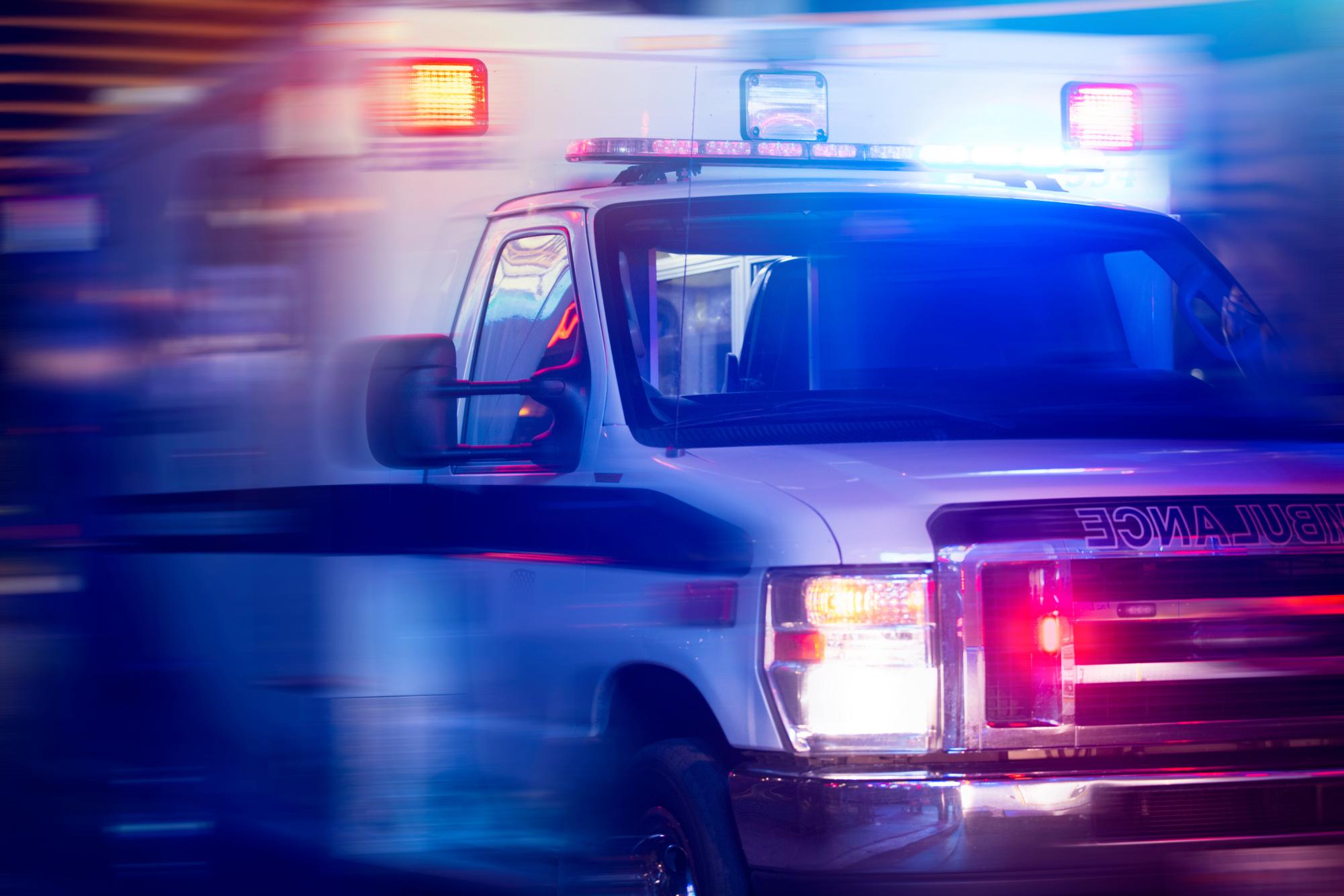
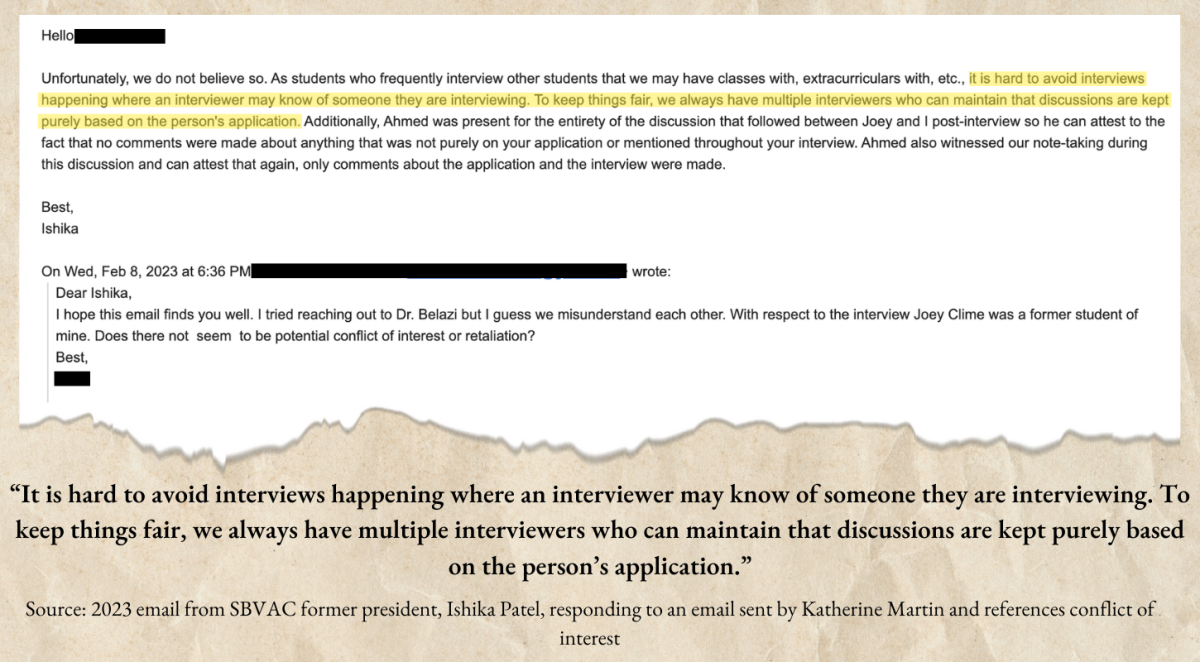
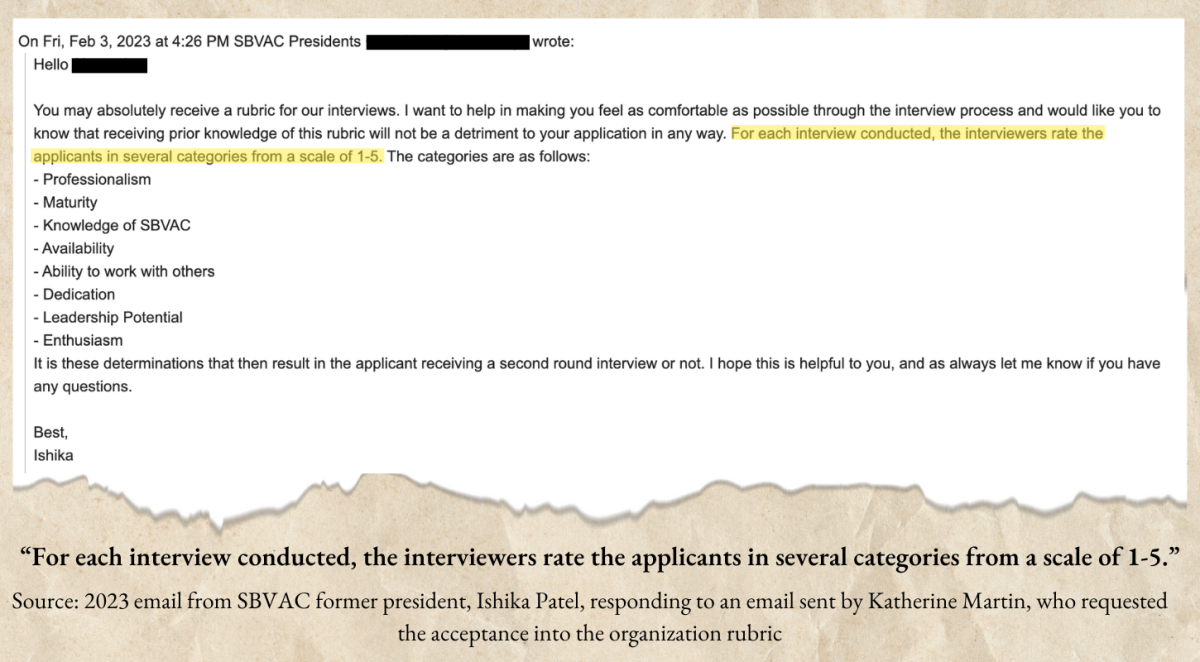
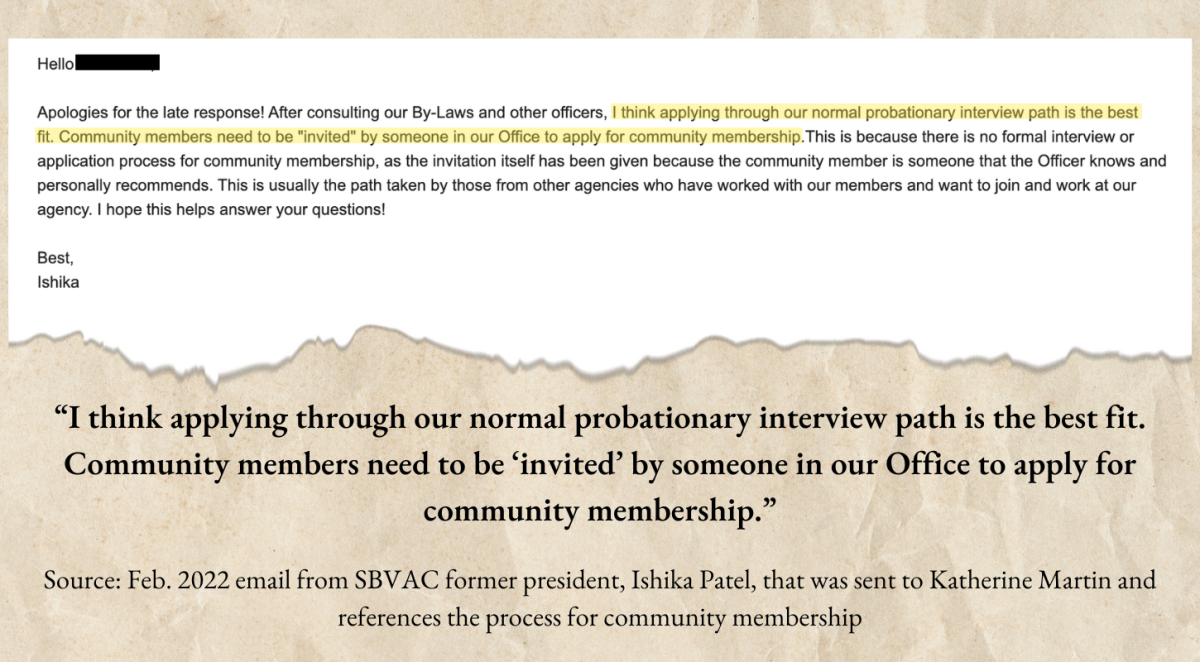
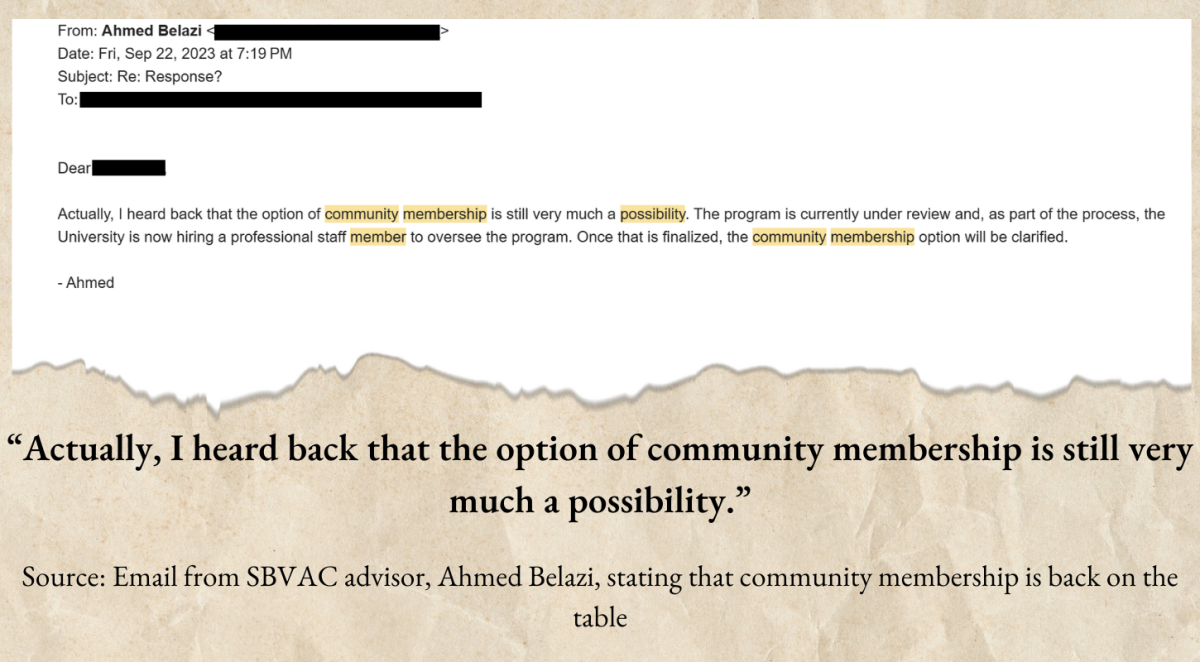
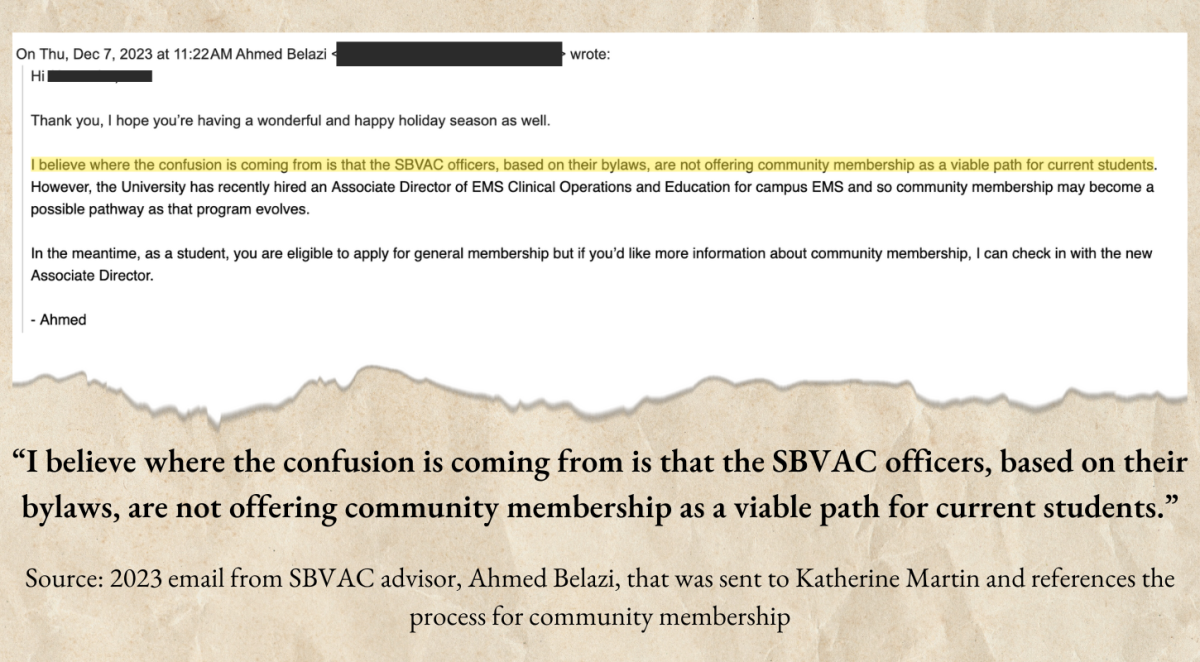
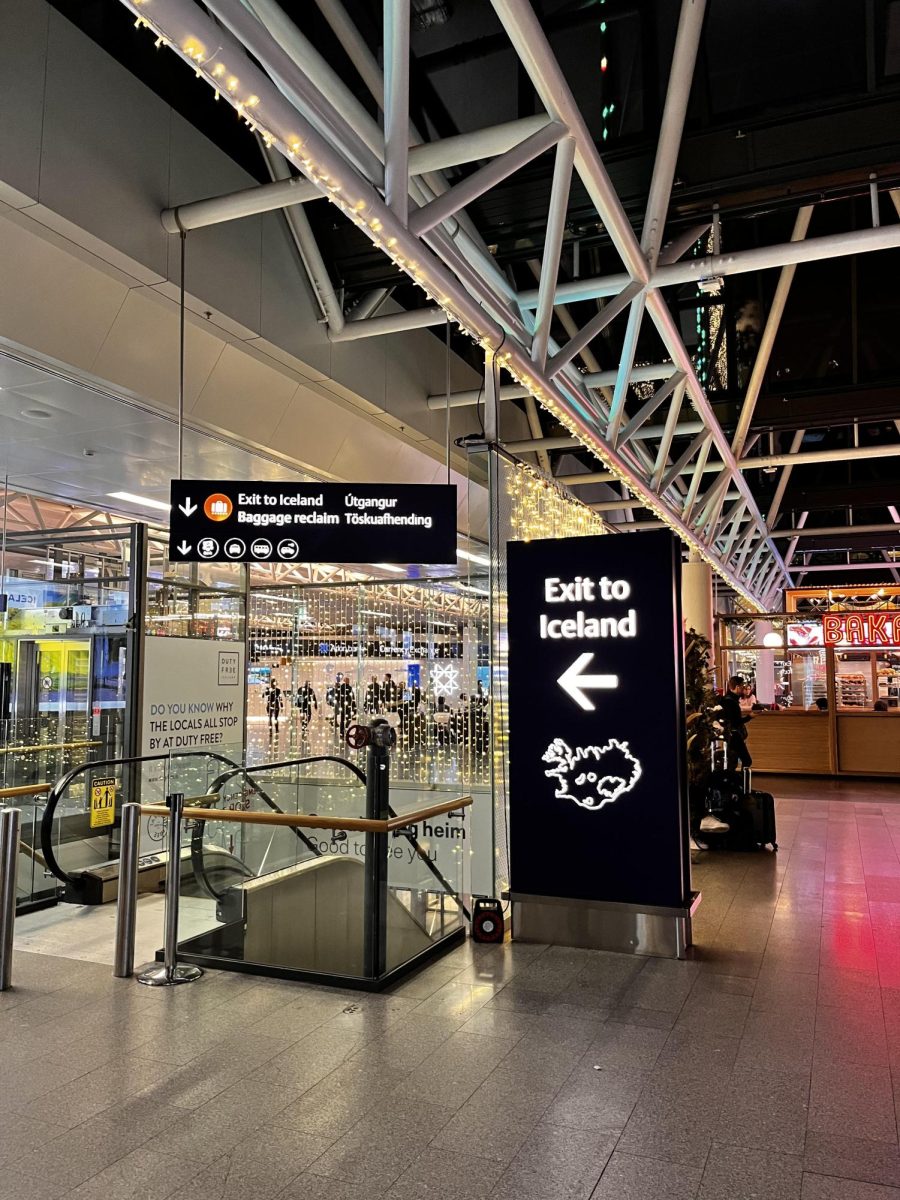

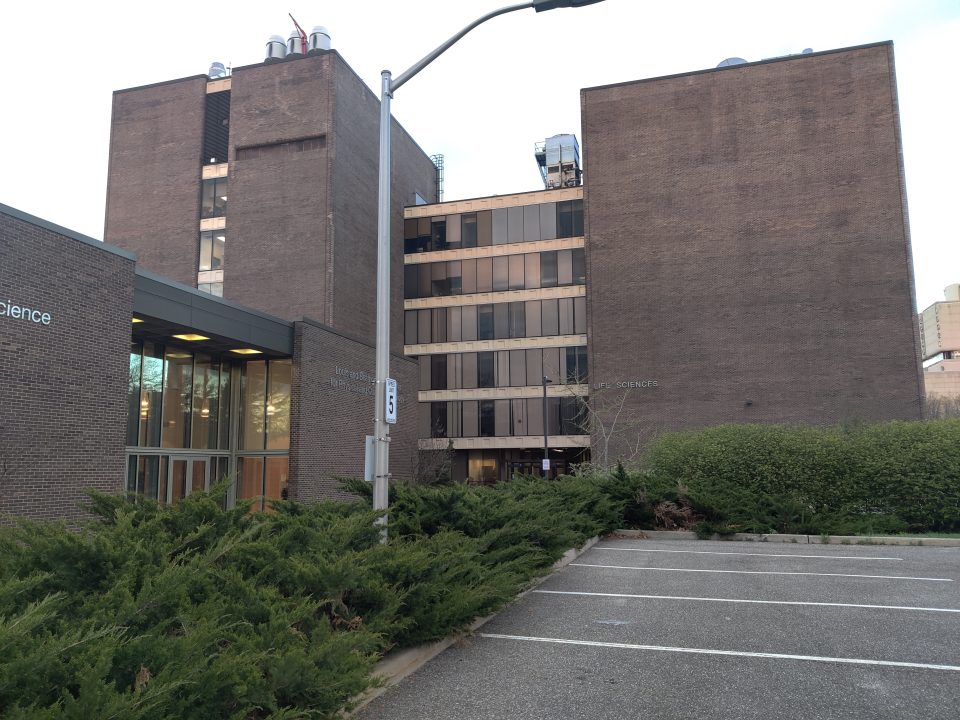
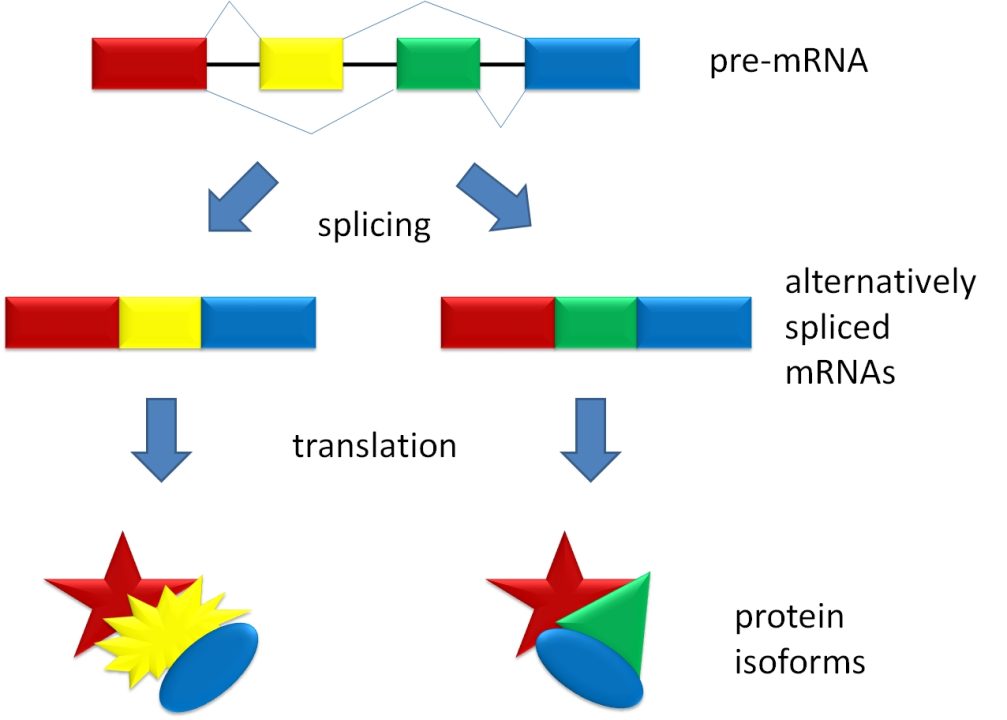












Anonymous • Apr 28, 2024 at 5:33 pm
I am also an SBU student and Paramedic in Suffolk County. I am not a member and do not have any knowledge of the author’s experience beyond what she has written. I can confirm though that SBVAC’s reputation within the EMS community is sub-par. I can also confirm that SBVAC was investigated by the DOH and did lose ALS credentialing. I have also heard negative things from ALS providers who have worked with and around SBVAC in the past. It sounds to me like a lot of the accusations are true.
Concerned SBU Junior • Apr 24, 2024 at 4:12 pm
Seems to me like SBVAC owes Katherine an apology because it sounds like she has legitimate points throughout the article and that she genuinely wants the best for the campus… the advisor also sounds pretty wack for not having more control over the organization. Disappointed to hear about this and SBVAC being a harm to the stony brook community.
Danielle • Apr 24, 2024 at 5:01 am
I believe LOVE has 4 letters but so does HATE. The article shows the amount of hatred that SBVAC and their advisor displayed toward the writer which extends to the community. It is so obvious that the comments degrading the writer are written by people in SBVAC. Clearly you know her and are ready to slander her even though the article she has written has a lot of emails backing up her story. It is funny how you never comment on those. I think she is trying to help you from the outside and she seems to be doing a better job than you guys are ruining your reputation from the inside. I think covering up what is really going on is not really going to work out well since the cat is already out of the bag and MULTIPLE people have shared similar experiences to her so what are all those other people also bad and a liability to sbvac. Maybe SBVAC is a liability to themselves? Seems like a pattern and cycle of abuse. After reading this article, I personally feel less safe on this campus. My suggestion is owning up to your mistakes and in the intersession apologizing to the writer and the whole community.
Anonymous • Apr 23, 2024 at 3:44 am
The person who wrote this is hiding their name because they are known in the Long Island EMS community, have been fired from several departments, and would be a liability if hired by SBVAC. This is a hit piece from a disgruntled individual and nothing more.
Abby • Apr 23, 2024 at 3:53 pm
Dear SBVACer,
You don’t even know how to copy & paste properly from Reddit:
“Active Suffolk County paramedic here:The person who wrote this article is known in the Long Island EMS Community and has been fired from several agencies for various reasons. Hiring her would only be a liability to SBVAC. I have worked with SBVAC off campus and have only had positive interactions with them.”
Why don’t you share evidence with us because the article has no slander. In fact, your statement is libel. Seems like you guys know clearly know how to retaliate.
Anonymous • Apr 22, 2024 at 9:00 pm
This person has a bad reputation in the EMS community and does not have a clue in the world. Just a hit piece by a disgruntled person who clearly isn’t a good fit.
Abby • Apr 23, 2024 at 5:41 pm
Dear SBVACer,
Sounds like you know the reasons for her rejection why don’t you share them with us. “Isn’t a good fit” isn’t that what your catch all phrase is. You guys never even gave her a chance. She clearly has a clue on what she is doing because she wrote this article in a way that speaks volume instead of slandering people like you are. This article shows how much she cares and wants change and I think the university campus does as well.
Anonymous • Apr 23, 2024 at 7:38 pm
Paramedic elsewhere, not in SBVAC
Katherine Martin • Apr 24, 2024 at 9:28 am
You have no idea who I am. I would not have so many per-diem jobs if I had no clue what I was doing. I would probably not be a paramedic for starters. Why don’t you email the statesman with all your information.
Rae • Apr 22, 2024 at 8:26 pm
As someone who applied 3 times and was rejected all three times, I can completely attest to their fraternity-like “application” process. It’s all about who you know and never about what you know. Luckily, I stopped applying and decided instead of apply myself elsewhere and now I work in Bellevue Hospital and did it without SBVAC’s help. They’re understaffed and have overinflated egos that put the community they serve in danger.
Scott • Apr 22, 2024 at 5:31 pm
I applied to SBVAC when I was a freshman in 2014. I already held an EMT-Basic certification from my out of state volunteer fire department. I was denied. I reapplied the next year with my paramedic certification, denied again. Another agency in the area was happy to take me on as a volunteer and I happily served with them them for 4 years. The need for ALS providers was just as high then as it is now and the same issues were prevalent with only two ALS providers per shift.
As my time at Stony Brook progressed, I felt I dodged a bullet with SBVAC denying me.
Janice D • Apr 22, 2024 at 3:25 pm
Yup, as I was reading this “article”, I knew somewhere down the line there was going to be a mention of how there was discrimination because she was a woman; and BAM!!! There it was. Btw, before you start throwing terms around like “spoken like a typical male” or using words like “fragile” or “man-splaining”, know that I am a woman and that whole article she wrote is nothing more than a woman looking to blame shift and use every excuse to blame men and anyone else. God-forbid she simply wasn’t hired because of other reasons (personality, being combative, etc.). My guess is that the people that interviewed her could easily see through her as being a combative-entitled person. Just reading her article screams of someone who will victim play and blame shift and just basically will be more problem than it’s worth. But hey, she tried playing the discrimination woman card. Let’s see if that works…..
Anonymous • Apr 22, 2024 at 10:14 am
Which editor decided that allowing a blatant hit piece riddled with misinformation and unresolved personal anger was a good idea? Have SBVAC’s long-standing efforts to staff athletic events, university community events, and thousands of calls on campus all been forgotten? Yes, paramedics are important for care, but I would rather wait an extra 5-10 minutes to be taken care of by a paramedic that is not delusional enough to write this.
Anthony • Apr 22, 2024 at 11:12 am
There are cases where you cannot wait another 5-10 minutes. Your attitude and blatant bias for a disgusting incompetent organization is showing. Why should students have to wait longer for a paramedic, when there are students and staff with said qualifications and skills willing to volunteer their precious time. SBVAC is nothing more than a glorified fraternity hiding behind the mask of medicine. You should be ashamed of yourself for your ignorant comment. You sound like someone in ivory tower telling peasants to eat cake if they are hungry.
Anonymous • Apr 22, 2024 at 12:30 pm
This comment was far more biased than anything I wrote. I agreed with your sentiment that paramedics are important, but my disagreement with the article stemmed from the entitlement of the author. Being hired in any context requires an interview for a reason, and sometimes personality can be a huge factor. I would never say that physicians are not important, but I wouldn’t hire Dr. Frankenstein just because he has the degree.
Anonymous • Apr 22, 2024 at 12:10 pm
I commend this author for writing this, as I was in a similar position. As a paramedic with way more experience and certifications than needed to be accepted into the department as an ALS provider, I was also rejected. I knew they were hurting for ALS providers, especially during the discontinuation of the Suffolk EMT-CC certification, and very few college students would be able to manage going through a paramedic program in addition to their full-time classes. It seems to me that they are just threatened by more experienced providers with a higher scope of practice. This will eventually hurt them as a department in the long run, and it already has. Everyone throughout the county already knows how much of a joke SBVAC is. It’s not that they don’t respond to calls, but would you rather have the best providers who can provide the best treatments respond, or providers with little to no experience outside a textbook? Clearly, it isn’t just my opinion. The rest of the EMS community in Suffolk County has already taken note of SBVAC’s inability to provide a standard of care to their patients that all other departments are providing. Without immediate change in the onboarding process or additional oversight, someone will get hurt, and I’d bet money that someone already has.